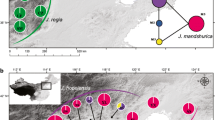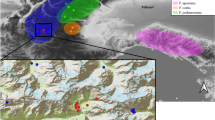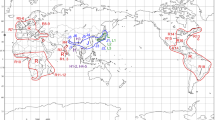Abstract
Key message
By comparing the phylogeography of Juglans regia and J. mandshurica, we found that two walnut species, even when sympatric, rarely introgress, suggesting that strong hybridization barriers exist between these species.
Abstract
The biogeographic investigation of temperate walnut (Juglans) trees is of great interest because of their ecological and economical importance. Our goal was to perform an in-depth investigation of the genetic and phylogeographic history of J. regia and J. mandshurica, two walnut species that are sympatric in parts of their ranges, including tests for gene flow and incomplete lineage sorting. We employed a 234 bp locus of mitochondrial DNA, a 1.8 Kbp locus of chloroplast DNA, 3 nuclear loci totaling 1740 bp in length, and 17 EST-SSRs. We sampled 559 individuals, 332 of J. regia and 227 of J. mandshurica, from 69 locations. We found that J. regia and J. mandshurica, even when sympatric, rarely introgress, suggesting that strong barriers to hybridization exist between these species. Niche overlap analyses for the two species found that they occupy distinct ecological niches and that the sympatric populations may be the result of recent postglacial population expansion.




Similar content being viewed by others
References
Alonso S, Armour J (2001) A highly variable segment of human subterminal 16p reveals a history of population growth for modern humans outside Africa. Proc Natl Acad Sci USA 98:864–869
Antonelli A, Kissling WD, Flantua SGA, Bermúdez MA et al (2018) Geological and climatic influences on mountain biodiversity. Nat Geosci 11:718–725
Avise JC (1998) Pleistocene phylogeographic effects on avian populations and the speciation process. Proc R Soc Lond B Biol Sci 265:457–463
Avise JC (2000) Phylogeography: the history and formation of species. Harvard University Press, Cambridge
Avise JC (2009) Phylogeography: retrospect and prospect. J Biogeography 36:3–15
Aradhya MK, Potter D, Gao F et al (2007) Molecular phylogeny of Juglans (Juglandaceae): a biogeographic perspective. Tree Genet Genomes 3:363–378
Bai WN, Liao WJ, Zhang DY (2010) Nuclear and chloroplast DNA phylogeography reveal two refuge areas with asymmetrical gene flow in a temperate walnut tree from East Asia. New Phytol 188:892–901
Bai WN, Wang WT, Zhang DY (2014) Contrasts between the phylogeographic patterns of chloroplast and nuclear DNA highlight a role for pollen-mediated gene flow in preventing population divergence in an East Asian temperate tree. Mol Phylogenet Evol 81:37–48
Bai WN, Wang WT, Zhang DY (2015) Phylogeographic breaks within Asian butternuts indicate the existence of a phytogeographic divide in East Asia. New Phytol 209:1757–1772
Bandelt HJ, Forster P, Röhl A (1999) Median-joining networks for inferring intraspecific phylogenies. Mol Biol Evol 16:37–48
Barton NH, Gale KS (1993) Genetic analysis of hybrid zones. In: Harrison RG Hybrid Zones and the Evolutionary Process. Oxford University Press, Ed, New York NY USA 13–45
Beerli P (2005) Comparison of Bayesian and maximum-likelihood inference of population genetic parameters. Bioinformatics 22:341–345
Broennimann O, Fitzpatrick MC, Pearman PB et al (2011) Measuring ecological niche overlap from occurrence and spatial environmental data. Global Ecol Biogeogr 21:481–497
Casazza G, Grassi F, Zecca G, Minuto L (2016) Phylogeographic insights into a peripheral refugium: the importance of cumulative effect of glaciation on the genetic structure of two endemic plants. PloS One 1:e0166983
Chen DM, Zhang XX, Kang HZ, Sun X, Yin S, Du HM, Yamanaka N et al (2012) Phylogeography of Quercus variabilis based on chloroplast DNA sequence in East Asia: multiple glacial refugia and mainland-migrated island populations. PloS One 7:e47268
Dang M, Liu ZX, Chen X et al (2015) Identification, development, and application of 12 polymorphic EST-SSR markers for an endemic Chinese walnut (Juglans cathayensis L.) using next-generation sequencing technology. Biochem Syst Ecol 60:74–80
Dang M, Yue M, Zhang M, Zhao GF, Zhao P (2019) Gene introgression among closely related species in sympatric populations: a case study of three walnut (Juglans) species. Forests 10:965
Dreyer JBB, Higuchi P, Silva AC (2019) Ligustrum lucidum W. T. Aiton (broad-leaf privet) demonstrates climatic niche shifts during global-scale invasion. Sci Rep 9:3813
Doyle JJ, Doyle JL (1987) A rapid DNA isolation procedure for small quantities of fresh leaf tissue. Phytochem Bull 19:11–15
Du FK, Petit RJ, Liu JQ (2009) More introgression with less gene flow: chloroplast vs. mitochondrial DNA in the Picea asperata complex in China, and comparison with other conifers. Mol Ecol 18:1396–1407
Earl DA, vonHoldt BM (2012) STRUCTURE HARVESTER: a website and program for visualizing STRUCTURE output and implementing the Evanno method. Conserv Genet Resour 4:359–361
Evanno G, Regnaut S, Goudet J (2005) Detecting the number of clusters of individuals using the software STRUCTURE: a simulation study. Mol Ecol 14:2611–2620
Excoffier L, Lischer HE (2010) Arlequin suite ver 3.5: a new series of programs to perform population genetics analyses under Linux and Windows. Mol Ecol Resour 10:564–567
Fan DM, Yue JP, Nie ZL, Li ZM, Comes HP, Sun H (2013) Phylogeography of Sophora davidii (Leguminosae) across the ‘Tanaka-Kaiyong Line’, an important phytogeographic boundary in Southwest China. Mol Ecol 22:4270–4288
Feng XJ, Yuan XY, Sun YW et al (2018a) Resources for studies of Iron walnut (Juglans sigillata) gene expression, genetic diversity and evolution. Tree Genet Genomes 14:51
Feng XJ, Zhou HJ, Saman Z et al (2018b) The phytogeographic history of common walnut in China. Front Plant Sci 9:1399
Fuertes AJ, Nieto FG (2003) Additive polymorphisms and reticulation in an ITS phylogeny of thrifts (Armeria, Plumbaginaceae). Mol Phylogenet Evol 28:430–447
Fuertes AJ, Rosselló JA, Nieto FG (1999) Nuclear ribosomal DNA (nrDNA) concerted evolution in natural and artificial hybrids of Armeria (Plumbaginaceae). Mol Ecol 8:1341–1346
Fu YX, Li WH (1993) Statistical tests of neutrality of mutations. Genetics 133:693–709
Gugger PF, Sugita S, Cavender-Bares J (2010) Phylogeography of Douglas-fir based on mitochondrial and chloroplast DNA sequences: testing hypotheses from the fossil record. Mol Ecol 19:1877–1897
Hall TA (1999) BioEdit: a user-friendly biological sequence alignment editor and analysis program for Windows 95/98/NT. Nucl Acids Sympos Series 41:95–98
Han H, Woeste KE, Hu YH et al (2016) Genetic diversity and population structure of common walnut (Juglans regia) in China based on EST-SSRs and the nuclear gene phenylalanine ammonia-lyase (PAL). Tree Genet Genomes 12:111–122
Hoban SM, McCleary T, Schlarbaum S et al (2009) Geographically extensive hybridization between the forest trees American butternut and Japanese walnut. Biol Lett 5:324–327
Hu YH, Dang M, Feng XJ, Woeste KE, Zhao P (2017a) Genetic diversity and population structure in the narrow endemic Chinese walnut Juglans hopeiensis Hu: implications for conservation. Tree Genet Genomes 13:91
Kalinowski ST (2005) HP-Rare: A computer program for performing rarefaction on measures of allelic diversity. Mol Ecol 5:187–189
Levsen ND, Tiffin P, Olson MS (2012) Pleistocene speciation in the genus Populus (Salicaceae). Syst Biol 61:401–412
Librado P, Rozas J (2009) DnaSP v5: a software for comprehensive analysis of DNA polymorphism data. Bioinformatics 25:1451–1452
Liu JQ, Sun YS, Ge XJ, Gao LM, Qiu YX (2012) Phylogeographic studies of plants in China: advances in the past and directions in the future. J Syst Evol 50:267–275
Liu Y, Wang Y, Huang H (2009) Species-level phylogeographical history of Myricaria plants in the mountain ranges of western China and the origin of M. laxiflora in the Three Gorges mountain region. Mol Ecol 18:2700–2712
Lowry DB, Modliszewski JL, Wright KM (2008) The strength and genetic basis of reproductive isolating barriers in flowering plants. Philos Trans R Soc B Biol Sci 363:3009–3021
Lu AM, Stone DE, Grauke LJ (1999a) Juglandaceae. In: Wu ZY, Raven PH (Eds) Flora of China. Science Press. Beijing 4: 282–283
Lu AM, Stone DE, Grauke LJ (1999) Juglandaceae. Flora China 4:277–285
Manning WE (1978) The classification within the Juglandaceae. Ann Missouri Bot Gard 65:1058–1087
Mu XY, Sun M, Yang PF et al (2017) Unveiling the identity of wenwan walnuts and phylogenetic relationships of Asian Juglans species using restriction site-associated DNA-sequencing. Front Plant Sci 8:1708
Nagata N (2010) Mechanisms for independent cytoplasmic inheritance of mitochondria and plastids in angiosperms. J Plant Res 123:193–199
Papadopouloua A, Knowlesa LL (2016) Toward a paradigm shift in comparative phylogeography driven by trait-based hypotheses. P Natl Acad Sci USA 113:8018–8024
Peakall R, Smouse PE (2012) GenAlEx 6.5: genetic analysis in Excel. Population genetic software for teaching and research—an update. Bioinformatic 28:2537–2539
Petitpierre B, Kueffer C, Broennimann O, Randin C et al (2012) Climatic niche shifts are rare among terrestrial plant invaders. Science 335:1344–1348
Pollegioni P, Woeste KE, Chiocchini F et al (2014) Landscape genetics of Persian walnut (Juglans regia L.) across its Asian range. Tree Genet Genomes 10:1027–1043
Pollegioni P, Olimpieri I, Woeste KE et al (2013) Barriers to interspecific hybridization between Juglans nigra L. and J. regia L. species. Tree Genet Genomes 9:291–305
Pollegioni P, Woeste KE, Chiocchini F et al (2015) Ancient humans influenced the current spatial genetic structure of common walnut populations in Asia. PLoS One 10:e0135980
Pons O, Petit RJ (1996) Measwring and testing genetic differentiation with ordered versus unordered alleles. Genetics 144:1237–1245
Qiu YX, Fu CX, Comes HP (2011) Plant molecular phylogeography in China and adjacent regions: tracing the genetic imprints of Quaternary climate and environmental change in the world’s most diverse temperate flora. Mol Phylogenet Evol 59:225–244
Schneider S, Roessli D, Excoffier L (2000) Arlequin: a software for population genetics data analysis. User Manual Ver 2:2496–2497
Shu Z, Zhang X, Yu DQ et al (2016) Natural hybridization between Persian walnut and Chinese walnut revealed by simple sequence repeat markers. J Am Soc Hortic Sci 141:146–169
Stanford AM, Harden R, Parks CR (2000) Phylogeny and biogeography of Juglans (Juglandaceae) based on matK and ITS sequence data. Am J Bot 87:872–882
Sun YW, Hou N, Woeste KE et al (2019) Population genetic structure and adaptive differentiation of iron walnut Juglans regia subsp. sigillata in southwestern China. Ecol Evol 9:14154–14166
Sunnucks P (2000) Efficient genetic markers for population biology. Trends Ecol Evol 15:199–203
Tajima F (1989) Statistical method for testing the neutral mutation hypothesis by DNA polymorphism. Genetics 123:585–595
Takezaki N, Nei M, Tamura K (2010) POPTREE2: Software for constructing population trees from allele frequency data and computing other population statistics with windows interface. Mol Biol Evol 27:747–752
Tamura K, Stecher G, Peterson D et al (2013) MEGA6: molecular evolutionary genetics analysis version 6.0. Mol Biol Evol 197:2725
Van LM, Joseph JA, Heinze B, Fay MF, Lexer C (2008) Clonality and spatial genetic structure in Populus×canescens and its sympatric backcross parent P. alba in a central European hybrid zone. New Phytol 177:506–516
Waikhom B, Anirudh K et al (2015) Nucleotide diversity analysis of three major bacterial blight resistance genes in rice. Plos One 10:e0120186
Wang WT, Xu B, Zhang DY, Bai WN (2016) Phylogeography of postglacial range expansion in Juglans mandshurica (Juglandaceae) reveals no evidence of bottleneck, loss of genetic diversity, or isolation by distance in the leading-edge populations. Mol Phylogenet Evol 102:255–264
Wang J, Kallman T, Liu J, Guo Q et al (2014) Speciation of two desert poplar species triggered by Pleistocene climatic oscillations. Heredity 112:156–164
Wickham H (2009) ggplot2, elegant graphics for data analysis. Springer, New York
Woeste K, Michler C (2011) Genomic and breeding resources. In: Chittaranjan K (ed) Wild Crop Relatives. Springer, Berlin/Heidelberg, Germany
Wolfe KH, Li WH, Sharp PM (1987) Rates of nucleotide substitution vary greatly among plant mitochondrial, chloroplast, and nuclear DNAs. Proc Natl Acad Sci USA 84:9054–9058
Wolfe KH, Sharp PM, Li WH (1989) Rates of synonymous substitutions in plant nuclear genes. J Mol Ecol 29:208–211
Wright S (1978) Variability within and among natural populations. University of Chicago Press, Chicago
Yuan XY, Sun YW, Bai XR, Dang M et al (2018) Population structure, genetic diversity, and gene introgression of two closely related walnuts (Juglans regia and J. sigillata) in Southwestern China revealed by EST-SSR markers. Forests 9:646
Zhao P, Woeste KE (2011) DNA markers identify hybrids between butternut (Juglans cinerea L.) and Japanese walnut (Juglans ailantifolia Carr.). Tree Genet Genomes 7:511–533
Zhao P, Zhou HJ, Potter D, Hu YH, Feng XJ, Dang M et al (2018) Population genetics, phylogenomics, and hybrid speciation of Juglans in China determined from whole chloroplast genomes, transcriptomes, and genotyping-by-sequencing (GBS). Mol Phylogenet Evol 126:250–265
Acknowledgements
We thank Nan Hou, Yiheng Hu, Tao Zhou, and Lei Wang for assisting with sampling. Mention of a trademark, proprietary product, or vendor does not constitute a guarantee or warranty of the product by the U.S. Department of Agriculture and does not imply its approval to the exclusion of other products or vendors that also may be suitable.
Funding
This work was supported by the National Natural Science Foundation of China (32,070,372, 41,471,038, and 31,200,500), Shaanxi Academy of Science Research Funding Project (2019 K-06), the Natural Science Foundation of Shaanxi Province of China (2019JM-008), the Opening Foundation of the Key Laboratory of Resource Biology and Biotechnology in Western China (Northwest University), the Ministry of Education (ZSK2018009), and the Program for Excellent Young Academic Backbones, funded by Northwest University.
Author information
Authors and Affiliations
Corresponding author
Ethics declarations
Conflict of interest
The authors declare no conflict of interest.
Additional information
Communicated by José I Hormaza .
Publisher’s Note
Springer Nature remains neutral with regard to jurisdictional claims in published maps and institutional affiliations.
Supplementary Information
Below is the link to the electronic supplementary material.
468_2021_2167_MOESM1_ESM.tif
Supplementary Fig. S1 Geographic distribution of sequence in variation in J. regia and J. mandshurica at the (nuclear) 15R-8 sequence. a Locations where more than one allele per population was encountered are represented as pie charts that show the proportion of each allele. We added a black border to the pie chart of J. mandshurica. b The network of genealogical relationships for the 81 alleles at 15R-8 found among all samples in this study. The black lines show the connections inferred between the alleles, based on parsimonious mutation models. The size of the circles is roughly proportional to the number of alleles of that type encountered; the smallest circles represent one tree each. Abbreviations for samples, numbers of populations, and sampling details are in Table 1. (TIF 14115 KB)
468_2021_2167_MOESM2_ESM.tif
Supplementary Fig. S2 Geographic distribution of sequence in variation in J. regia and J. mandshurica based on Jr5680 sequence data. a Geographical distribution of the haplotypes of all sampled locations in China. The green and amber circles (single color and number inside) indicate the population contained only one haplotype. We added a black border to the pie chart of J. mandshurica. b The network of genealogical relationships among the 22 haplotypes found in this study. Black lines show the connections inferred between the haplotypes, based on parsimonious mutation models. The size of circles for haplotypes is roughly proportional to the number of samples with the indicated haplotype. The remaining haplotypes represent one tree each. (TIF 20723 KB)
468_2021_2167_MOESM3_ESM.tif
Supplementary Fig. S3 Using MEGA 6.0 (Tamura et al. 2013) to construct the maximum likelihood (ML) phylogenetic tree based on the nuclear DNA (ITS, 15R-8, and Jr5680) sequences, with 1,000 bootstrap replicates. (TIF 25337 KB)
468_2021_2167_MOESM4_ESM.tif
Supplementary Fig. S4 Mismatch distribution analysis using mtDNA a, b, cpDNA c, d, and data on three types of nuclear DNA e‒j. a Mismatch distribution results of J. regia from mtDNA data; b Mismatch distribution results of J. mandshurica from mtDNA data; c Mismatch distribution results of J. regia from cpDNA data; d Mismatch distribution results of J. mandshurica from cpDNA data; e, g, i Mismatch distribution results of J. regia from nrDNA data ITS, 15R-8, and Jr5680, respectively. f, h, j Mismatch distribution results of J. mandshurica from nrDNA data ITS, 15R-8, and Jr5680, respectively (TIF 25337 KB)
468_2021_2167_MOESM5_ESM.docx
Supplementary Table S1 Details of sample locations and sample sizes in 77 populations in this study, and the number of samples analyzed for multiple DNA fragments. (DOCX 31 KB)
468_2021_2167_MOESM6_ESM.docx
Supplementary Table S2 The nine mitochondrial DNA markers, 18 chloroplast DNA markers, and 17 microsatellite markers used to scan all samples in this study. (DOCX 19 KB)
468_2021_2167_MOESM7_ESM.docx
Supplementary Table S3 Details of sample location, sample size and descriptive statistics of genetic variability for eight Juglans regia L. populations and eight Juglans mandshurica M. populations in China based on EST-SSRs data. (DOCX 21 KB)
468_2021_2167_MOESM8_ESM.docx
Supplementary Table S4 Information related to primers and genetic characteristics of 17 EST-SSR primers for 16 walnut populations used in this study. (DOCX 19 KB)
468_2021_2167_MOESM9_ESM.pdf
Supplementary Table S5 Genetic variable sites of eleven haplotypes based on mitochondrial DNA marker 3-9 dataset. (PDF 62 KB)
468_2021_2167_MOESM10_ESM.pdf
Supplementary Table S6 Genetic variable sites of 11 haplotypes based on chloroplast DNA marker trnL-F and trnS-G dataset. (PDF 128 KB)
468_2021_2167_MOESM14_ESM.docx
Supplementary Table S10 Estimated gene flow between sympatric J. regia vs J. mandshurica populations by Migtate 3.6.4. (DOCX 15 KB)
Rights and permissions
About this article
Cite this article
Dang, M., Zhou, HJ., Woeste, K.E. et al. Comparative phylogeography of Juglans regia and J. mandshurica combining organellar and nuclear DNA markers to assess genetic diversity and introgression in regions of sympatry. Trees 35, 1993–2007 (2021). https://doi.org/10.1007/s00468-021-02167-y
Received:
Accepted:
Published:
Issue Date:
DOI: https://doi.org/10.1007/s00468-021-02167-y




